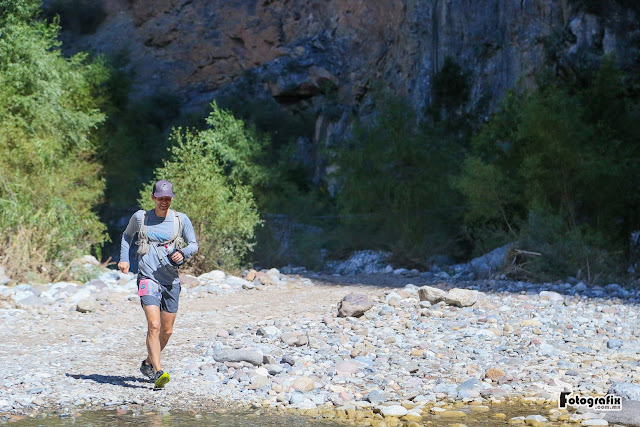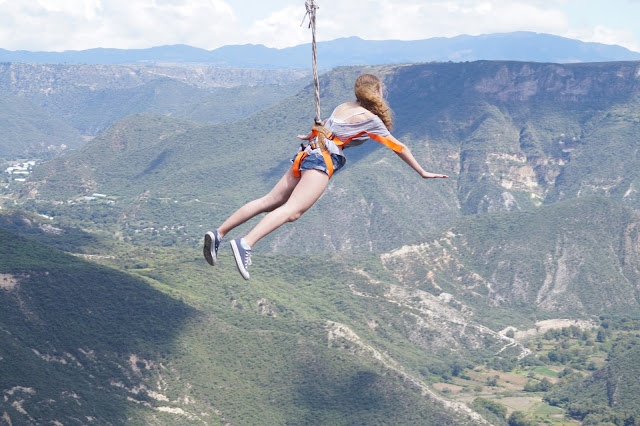 |
| Sierra Gorda 50k: Photo by Martin Forstmann of Fotografix.com.mx |
No way I was
pitching a tent in a parking lot.
Forstmann –of
Fotografix.com.mx fame-- and I had driven about 4 hours to the tiny, remote
town of Higueras de Peñamiller for the Reto Sierra Gorda 50k. We stopped for
carnitas in Peña Bernal, a well-known tourist trap where people go to look at a
big rock, and then we drove about an hour into the semi-desert, mountainous
region known as the Sierra Gorda.
| Peña de Bernal: Keep driving and send your last texts |
The sun would go
down and eventually someone would turn off the music, but dusty and hard
weren’t going away. I was prepared to drive up into the hills and find a place
on the side of the road.
After asking around
a bit, we heard that “the Oasis” was a nice place to camp and not too far, so
we drove up out of the town and on a dirt road inside a canyon. Someone had
painted “Oasis” and an arrow on the side of the canyon so we headed down an
even narrower road would soon turned into a river. Wondering how wise it was to
be driving down a river as the sun set, I stopped the car and ran ahead to
check out the road/river. A guy with a machete popped out of the woods, and I
asked him about the Oasis and he told me to keep on driving down the river.
| The "road" to the Oasis |
After setting up the
tent, Martin made his magical camp pasta sauce which we enjoyed with the
Victorias. I was so happy at the Oasis that I momentarily forgot that I would
be running a 50k the next morning after the 5 weeks of rest, easy jogging and pastries
that have been my focus since running UTMX on October 10.
| Chef Martin |
Martin’s Magical Camp Pasta Sauce
Preparation and
Cooking Time: 2 minutes, 41 seconds
1 Jar of Pasta Sauce
1 can of black olives
1 can of tuna
1 yogurt size jar of cream
Recommended Beer Pairing: 17 peso Victorias.
| Under the moon at the Oasis Photo: me |
It was tough to say
what the course would be like. Martin went on a reconnaissance mission and
talked to some of the other campers. He returned and I asked him what he found
out.
He laughed. “Nadie Sabe Nada.”
Well, we all love a good mystery, and I had just driven my
family car at dusk down a sketchy canyon road into a river in an area that was
at good hour from cell phone reception, and stumbled upon the Oasis, so maybe
the race would work out as well.
However, just in
case the race didn’t work out, I opted for my pack (something I don’t even use
for the 100 mile distance) to make sure I had what I needed in case aid
stations didn’t materialize when they were supposed to or the course wasn’t
properly marked.
After a terrible
night of tossing and turning and looking at my phone 19 times to see if it was
4 AM already so I could just get up and get this over with, I looked at my
phone for the 20th time, and it was 3:37. I stayed horizontal for 23
more minutes listening to the sounds of the river and then we both got up,
packed up, made a coffee and hit the road/river. My car made it back up the
river/road without issue. Things were looking up.
We arrived back at
the dirt parking lot and were among the first to arrive. Suddenly I was
freaking exhausted. Martin trudged back up the hill and back down to the Oasis.
Apparently, the race would head right down the river. Neither of us recalled
seeing any course markings.
I tried to sleep
fitfully in the car until it was time to line up. The sun was coming up and I
cursed the organizers for requiring a headlamp for a race that starts at 6:30.
And then I cursed myself for being such a rules follower, stuffed the useless
headlamp in my pack and we were off…
We headed down the
same river/road that led to the Oasis, and then followed the river further down.
A kilometer or so
later we took a left out of the river and started heading up a canyon. Here
there were more water sections, including one that came up to my neck if I
stood on my very tippy toes. We followed this river for a while, and then,
mercifully headed up out of the canyon onto a trail.
| Tough to keep the shoes dry through here |
Sadly, the trail
didn’t last long and then we were running in a dry, rocky river bed, heading
up. This went on for maybe an hour? I tried to occupy my time by checking out
what packs people were wearing and what they were carrying. One guy had a tube
of Neosporin I could see through the mesh of his new Salomon pack. Why?
In the distance I
could see the clouds covering some mountain peaks. I really hoped we were
heading up there, as it looked awesome.
Also, I’d about had it with rivers.
| Heading up to the clouds |
The course climbed
out of the river bed (yay!) and started heading up a dirt road (boo) that
looked to be heading straight up to the peak (yay!). As we got higher the road turned to trail
(yay!). I was feeling good, back on
familiar terrain. Near the top I stopped to read a bit about the Mission
Bucarreli and I took a photo of this map.
 |
| Hey, a map! |
On the back side of
the mountain, the trail turned to single track cut out of the side of the
mountain (double yay!) and it reminded me very much of the Sam Merrill trail in
the San Gabriel Mountains in Southern California.
We took this single
track down for over an hour. Definitely the best part of the race for me.
Something like 9 kilometers of downhill. I was passing people and feeling good.
At one point I saw a group of people gathered a few switchbacks below. Perhaps
someone had twisted an ankle?
When I arrived I
knew there were too many cooks in the kitchen but it didn’t feel right just to
blow by. I stopped and asked if I could do anything to help.
Holy shit. A woman
had clearly fallen and her face and one had were badly cut up. Wait, I suddenly
remembered the Neosporin guy, couldn’t be too far….
Then I noticed the
Salomon pack. Neosporin Guy was right next to me saving the day. She still
looked a bit shocked, but the group assured us they had the situation under
control and so a few of us that had just arrived kept running.
| Long descent on singletrack like this... |
As the trail began
to flatten out it got really hot, and I started to struggle. Things slowed
down. A few of the folks I’d passed on the downhill passed me here. We arrived
at a grassy paradise that was out of place in this desert terrain. I drank a terrible tasting electrolyte drink made for babies with diarrhea here and kept moving.
And once again: a
river crossing. My feet had finally dried so I stupidly tried to step across
some rocks to keep my feet dried. Note to future runners: don’t bother…the next
hour or so was crossing the river, running along the river or running in the
river. Amazing views here, and though I felt low and was moving very slowly, it
was worth the effort to see this canyon.
A while later I
finally came upon Martin taking photos. I pretended to run for the camera. I’d
been doing a lot of walking in this section. It’s hard to run in a river. It’s
also hard to run when you are really tired, but it’s more satsifying to blame
it on the river.
 |
| Pretending to run Photo: Martin Forstmann, Fotografix.com.mx |
And then we ran through some small settlements before we
descended, for the last time into –you’ll never guess—a river. After a short bit I realized this was the same damn river we started on. This thrilled me for a
couple reasons:
1.
It was the last river I would run in.
| The final stretch of river (again) |
2.
The race was nearly finished.
And the dirt parking lot came into site.
Damn I’m glad we didn’t camp there.
Other Random Thoughts:
Incredibly
beautiful area to see and if you are looking for a race that breaks the mold,
this might be the one. I don’t mean to be a grump, but for me the river running
did get a bit old. The mountain pass was fantastic, however, and would make for
a great run from the Oasis. My fears about the aid stations and/or course
markings were completely unfounded paranoia: course was marked relentlessly,
and the aid stations were Spartan, but sufficient.
| The Sierra Gorda: A spectacular place to run |
I don’t know if I’ll
be back for the race (though I probably will be), but I’ll definitely return to
camp at the Oasis and drink a few Victorias.












